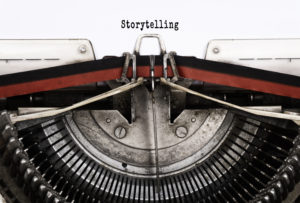Storytelling in life science marketing: The purposes of stories.
By David Chapin
SUMMARY
VOLUME 9
, NUMER 8
How can we create stories that stick? This is a crucial question for life science marketers. To understand how to create stories that stick we need to start with this question: What purposes do stories serve? The answers to this question will give us clues we can use to create a system for creating sticky stories.
Storytelling in life science marketing: The purposes of stories
Some stories are sticky
In our last issue we examined sticky stories. These stories convey messages that remain in our minds for years or decades. This is our goal as life science marketers, to create messages that stick.
How can we create sticky life science marketing stories? Well, we can find clues by examining both stories and storytelling closely. In our last issue I explored the prevalence of stories. Storytelling is universal; similar stories show up in many different cultures from all times in history. These similarities help us learn how to create messages that stick.
But before I dive more deeply into the factors that make stories sticky, we need to consider one more topic: what are stories for; that is, what role(s) do they play?
Why should we care about the purpose of stories? Examining this will give us significant clues to the way the brain perceives stories. And if we can understand the link between stories and the brain, we’ll have significant insight into how we can craft effective stories and messages that stick.
This is important stuff. If you don’t understand how the brain perceives stories, it will be harder to create compelling life science marketing messages. So let’s dive in.
Why story? What are stories for?
There are many theories about the purpose of stories. I won’t cover all of these, but it’s important to discuss a few. For example, stories help us remember facts better. Homo sapiens is a social species, and collective memory is important. Neuroeconomist Paul Zak writes, “…as social creatures who regularly affiliate with strangers, stories are an effective way to transmit important information and values from one individual or community to the next. Stories that are personal and emotionally compelling engage more of the brain, and thus are better remembered, than simply stating a set of facts.”
Alan Alda writes in his book, If I Understood You, Would I Have This Look on My Face: “The neuroscientist Antonio Dimarzio makes the same point when he calls stories “a fundamental way in which the brain organizes information in a practical and memorable manner.”[2]
But stories have many more purposes than just acting as a container for facts. As Jonathan Gottschall states in his book The Storytelling Animal: “The world’s priests and shamans knew what psychology would later confirm: if you want a message to burrow into a human mind, work it into a story.”[3]
Maybe stories exist to drive emotional engagement
Stories tap our emotions. Though there’s plenty of scientific data supporting this, you don’t need proof—you know this truth if you’ve ever cried watching a movie or felt your heart race when reading a novel. But science also knows that emotions underlie all decision making. So maybe stories can help people decide.
Humans do not make decisions based on reason alone. This may sound like heresy to those who have devoted years of their life to learning rational thought and applying it to the study of science, but the prevailing scientific evidence actually supports this idea strongly.
While scientific data has only accumulated recently, this idea (that emotions are necessary for decision making) has been understood for centuries. In 1740, David Hume, the Scottish philosopher, wrote in A Treatise of Human Nature: “Reason is, and ought only to be the slave of the passions, and can never pretend to any other office than to serve and obey them.”[4]
Benjamin Franklin wrote in his autobiography from 1791: “So convenient a thing is it to be a reasonable creature, since it enables one to find or make a reason for everything one had a mind to do.”[5] And in the book How the Mind Works the cognitive psychologist Steven Pinker states, “The emotions are mechanisms that set the brain’s highest level goals.”[6]
To see that humans do not make decisions based on reason alone, we need look no further than studies[7] of patients whose brains have been damaged in ways that leave their rational functions intact, while destroying their emotional abilities. As I’ve noted before, such patients are unable to make what we would consider normal, everyday decisions. In other words, emotions are necessary for decision making.
This hypothesis is supported by the work of Antonio Damasio, Professor of Neuroscience and Director of Brain and Creativity Institute at USC. Damasio studied a patient (“Elliot”) whose emotional abilities were destroyed during surgery to remove a tumor in his frontal lobe. Before the surgery, Elliot was “successful;” he had a good job, a family and was a role model to his colleagues. After the surgery, Elliot’s life fell apart. He made one bad decision after another. He ended up divorced, twice. He lost his job and had trouble with routine tasks.
Damasio realized that Elliot’s problem was not that the surgery had destroyed his intellect. It hadn’t—but it did destroy his ability to draw upon emotions to help make decisions, rendering his decision-making ability almost non-existent. To explain this, Damasio developed his somatic marker hypothesis.
This hypothesis posits that when you’re facing a decision, the rational portions of your brain can generate multiple alternative solutions easily. Elliot had no trouble with this. But there are often so many options that choosing becomes difficult; this was Elliot’s problem.
One of Damasio’s insights was to recognize the role that emotions play in processing these large numbers of alternatives. In essence, your body generates somatic signals to help you sort through the options by creating a “good” or “bad” feeling about each of the options. Without these feelings, all alternatives looked equal, so Elliot was paralyzed by indecision.
Emotions are necessary for decision making. So the question we’ll consider is: Can stories, which are frequently powerful, emotionally packed vehicles, affect our decisions?
Can stories affect decision making?
Writing about storytelling in the Harvard Business Review, author Harrison Monarth discusses a popular Budweiser ad featuring a puppy and a Clydesdale horse. He says, “Storytelling evokes a strong neurological response. Neuroeconomist Paul Zak‘s research indicates that our brains produce the stress hormone cortisol during the tense moments in a story, which allows us to focus, while the cute factor of the animals releases oxytocin, the feel-good chemical that promotes connection and empathy. Other neurological research tells us that a happy ending to a story triggers the limbic system, our brain’s reward center, to release dopamine which makes us feel more hopeful and optimistic.”[8]
Paul Zak himself writes in the October, 2014 issue of the Harvard Business Review about the effects of storytelling on brain chemistry. “More recently my lab wondered if we could “hack” the oxytocin system to motivate people to engage in cooperative behaviors. To do this, we tested if narratives shot on video, rather than face-to-face interactions, would cause the brain to make oxytocin. By taking blood draws before and after the narrative, we found that character-driven stories do consistently cause oxytocin synthesis. Further, the amount of oxytocin released by the brain predicted how much people were willing to help others; for example, donating money to a charity associated with the narrative.”[9]
Stories can alter your emotions and affect your decision making. That should be reason enough for life science marketers to study storytelling. But stories have other purposes as well—purposes that can help us understand how stories stick in our brains.
Maybe stories are a form of simulation
Stories might be a way to let humans simulate life. It’s easy to envision how telling and listening to stories might convey an evolutionary advantage. Imagine one of my ancestors telling one of yours, “Let me tell you about poor Grogg, who ate one of those green fruits. Here’s what happened…”
Jonathan Gottschall says, “The psychologist and novelist Keith Oakley calls stories the flight simulators of human social life.”[10] In other words, stories offer us a way to practice specific situations without putting ourselves at risk by actually participating in those situations.
Neuroscience supports the idea that experiencing stories helps us practice. A story can stimulate the same parts of the brain that would be stimulated if we participated in the action described in the story. According to an article in the New York Times, “The brain, it seems, does not make much of a distinction between reading about an experience and encountering it in real life; in each case, the same neurological regions are stimulated.” The article continues: “…a team of researchers from Emory University reported in Brain & Language that when subjects in their laboratory read a metaphor involving texture, the sensory cortex, responsible for perceiving texture through touch, became active. Metaphors like “The singer had a velvet voice” and “He had leathery hands” roused the sensory cortex, while phrases matched for meaning, like “The singer had a pleasing voice” and “He had strong hands” did not.”[11]
There is a hardwired connection between the brain and stories. Jonathan Gottschall says, “According to evolutionary thinkers such as Brian Boyd, Steven Pinker, and Michelle Scalise Sugiyama, story is where people go to practice the key skills of human social life.”[12] He goes on: “Fiction is a powerful and ancient virtual reality technology that simulates the big dilemmas of human life. The constant firing of our neurons in response to fictional stimuli strengthens and refines the neural pathways that lead to skillful navigation of life’s problems. Fiction allows our brains to practice reacting to the kinds of challenges that are, and always were, most crucial to our success as a species.”[13]
What are stories for? Maybe they’re virtual reality simulators, allowing us to preview experiences. The fact that our brains respond to story in the same way they respond to reality supports this notion. This hardwired connection between our brains and our culture gives us clues about why stories could be so sticky that they’d remain lodged in our brains for decades.
Maybe stories are just patterns
This idea that there is some hardwired connection between the human brain and stories is also supported by another theory of the purpose of stories. Some people think that stories aren’t “for” anything; rather, stories exist because our brains are wired to look for patterns.
Jonathan Gottschall explores this idea when he writes about the different purposes of stories: “What are stories for? Nothing. The brain is not designed for story; there are glitches in its design to make it vulnerable to story.”[14] Stories are patterns that hitchhike on our brain’s need to see patterns.
The science writer Michael Shermer in Scientific American discussed our brain’s search for patterns, even when they may not actually exist. He called this phenomenon “patternicity.” The scientific name for this condition is apophenia, defined as the tendency to perceive meaningful patterns within random data. I’ve discussed apophenia and the related condition pareidolia in a past issue.
As Shermer points out, this pattern-seeking behavior confers an evolutionary advantage. “For example, believing that the rustle in the grass is a dangerous predator when it is only the wind does not cost much, but believing that a dangerous predator is the wind may cost an animal its life. The problem is that we are very poor at estimating such probabilities, so the cost of believing that the rustle in the grass is a dangerous predator when it is just the wind is relatively low compared with the opposite. Thus, there would have been a beneficial selection for believing that most patterns are real.”[15]
Or, as Jonathan Gottschall summed it up in The Storytelling Animal, “The human mind is tuned to detect patterns, and it is biased towards false positives rather than false negatives.”[16]
We’ve been trained to see patterns, and to actively search for them. Humans are pattern-seeking animals. In fact, all of life is pattern-seeking. Shermer mentions that “…even such simple organisms as “Escherichia coli cells will swim towards physiologically inert methylated aspartate presumably owing to an adaptation to favour true aspartate.” In other words, the E. coli behave as if they recognize the pattern, even though the pattern is not real—the aspartate is physiologically inert.
So maybe stories aren’t “for” anything. Maybe they just tap into our brains’ patternicity. Maybe stories are just hitchhiking on our brains’ tendency towards apophenia, our need to see patterns.
Stories are powerful patterns
In this issue I’ve explored a few of the possible purposes stories might serve. There are many hypotheses. Stories might be ways to transmit information, that is, a way to help humans remember important information. Stories might drive emotional engagement and thereby help with decision making. Stories might be the “flight simulator” of life. Or stories might be patterns that harness our need to notice and identify patterns in life’s experiences.

What makes stories sticky has more to do with the structure of the story than the content. Compelling stories follow a clear structure.
What are stories for? Science hasn’t given us a definitive answer to this question. But we don’t have to select a single answer to realize that the hardwired connection between our brains and stories is something we can harness to convey our messages in life science marketing. We can do this by identifying, categorizing and harnessing the patterns in the structure of successful stories.
Stories are patterns. You see, what makes stories sticky is due more to the structure of the story than to the content. Compelling—that is, sticky—stories follow a clear, consistent structure. It turns out this is a clear, recognized pattern, one that occurs over and over again in all cultures, in all media. Great storytellers know this, whether they tell their stories out loud, put their words into novels, or create movies, advertisements, plays, opera or any other narrative form.
I entered the topic of storytelling in life science marketing by examining the topic of life science marketing case studies. This started when I realized there were so many different forms of case studies; some worked well, some barely worked at all. The best case studies are well-told stories. This led me into examining the secrets of effective storytelling. And after I’ve examined storytelling in detail, I’ll be able to come back to the topic of case studies, where we’ll use our ideal storytelling structure to create compelling case studies.
So, I’m close to wrapping up this topic. Thanks for sticking with me as we’ve detoured into diverse topics, such as the relationship between our brain’s hardwiring and stories. I’ll begin our next issue discussing the patterns that show up in sticky stories. I’ll isolate this sticky story structure, identify its components, and show how this enables the creation of stories in life science marketing that are powerful, effective and designed to stick.
[1] https://greatergood.berkeley.edu/article/item/how_stories_change_brain
[2] Alda, Alan If I Understood You, Would I Have This Look on My Face? My Adventures in the Art and Science of Relating and Communicating. New York: Random House, 2017. 167. Print.
[3] Gottshall, Jonathan The Storytelling Animal. How stories make us human. Boston: Mariner, 2012. 118. Print.
[4] http://www.pitt.edu/~mthompso/readings/hume.influencing.pdf
[5] http://www.ushistory.org/franklin/autobiography/page18.htm
[6] Pinker, Steven How the Mind Works. New York: W.W. Norton, 1997. 373. Print
[7] Bechara, A., ”The role of emotion in decision-making: evidence from neurological patients with orbitofrontal damage,” Brain Cogn. 2004 Jun; 55(1):30-40
[8] https://hbr.org/2014/03/the-irresistible-power-of-storytelling-as-a-strategic-business-too
[9] https://hbr.org/2014/10/why-your-brain-loves-good-storytelling
[10] Gottshcall Page 58
[11] http://www.nytimes.com/2012/03/18/opinion/sunday/the-neuroscience-of-your-brain-on-fiction.html
[12] Gottshall Page 57
[13] Gottshall Page 67
[14] Gottshall Page 29
[15] https://www.scientificamerican.com/article/patternicity-finding-meaningful-patterns/
[16] Gottshall Page 103
The Marketing of Science is published by Forma Life Science Marketing approximately ten times per year. To subscribe to this free publication, email us at info@formalifesciencemarketing.com.
David Chapin is author of the book “The Marketing of Science: Making the Complex Compelling,” available now from Rockbench Press and on Amazon. He was named Best Consultant in the inaugural 2013 BDO Triangle Life Science Awards. David serves on the board of NCBio.
David has a Bachelor’s degree in Physics from Swarthmore College and a Master’s degree in Design from NC State University. He is the named inventor on more than forty patents in the US and abroad. His work has been recognized by AIGA, and featured in publications such as the Harvard Business Review, ID magazine, Print magazine, Design News magazine and Medical Marketing and Media. David has authored articles published by Life Science Leader, Impact, and PharmaExec magazines and MedAd News. He has taught at the Kenan-Flagler Business School at UNC-Chapel Hill and at the College of Design at NC State University. He has lectured and presented to numerous groups about various topics in marketing.
Forma Life Science Marketing is a leading marketing firm for life science, companies. Forma works with life science organizations to increase marketing effectiveness and drive revenue, differentiate organizations, focus their messages and align their employee teams. Forma distills and communicates complex messages into compelling communications; we make the complex compelling.
© 2024 Forma Life Science Marketing, Inc. All rights reserved. No part of this document may be reproduced or transmitted without obtaining written permission from Forma Life Science Marketing.






